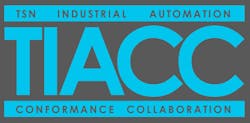TIACC: A Collaboration to Accelerate Coexistence
What you’ll learn:
- The TIACC partnership’s role in collaboration for industrial networking.
- The four primary benefits of time-sensitive networking.
- The value of having different networks and devices coexisting on the same physical wire managed with simple system-management tools.
TIACC (TSN Industrial Automation Conformance Collaboration) is a unique and important initiative that clearly demonstrates the value proposition of Ethernet time-sensitive networking (TSN) technology through the participation of competing organizations.
The leading industrial Ethernet organizations—CC-Link Partner Association, ODVA, OPC Foundation, PROFINET International, and AVNU—are working together to make sure that the solutions from their respective organizations are validated and tested together so that end customers may make use of a blended TSN architecture. The organization is focused on developing the necessary test specifications to ensure the coexistence of industry protocols.
Successful standards are measured by the levels of adoption of their technology. The way you achieve adoption of technical standards is to make sure that the standards are not academic exercises, and that they deliver tangible benefits. Standards organizations work aggressively to make sure their solutions are solving a problem that the consumers want solved!
The strategy with respect to technologies like Ethernet TSN is to create a set of services to be used by all other industrial Ethernet protocol organizations. Collaboration is required, specifically making their protocols leverage the new services in a way to deliver coexistence. A singular Ethernet standard—delivering services for traffic shaping, prioritization, and scheduling—cannot, on its own, enforce compliance.
In addition to developing the standards, owning organizations have a process in place to facilitate companies developing and releasing products that properly leverage their new services. Certification and validation are necessary to ensure that users of standards are releasing compatible products in a multi-vendor community.
TSN on the Rise
TSN is a technology that has been talked about as a game-changing technology because it provides a mechanism that facilitates multiple industrial and non-industrial protocols to run on the same physical wire. Communication to underlying devices in the operational technology (OT) world is the most important part of the infrastructure necessary for a digital transformation journey, and specifically addressing the ability to move data and information between disparate devices and applications.
Performance and reliability, ensuring that data isn’t lost, is a key part of the TSN technology. End users can prioritize and guarantee that the traffic from the respective devices meets and exceeds the requirements in a deterministic fashion. Most importantly, the reliability of data between various end points is critical and necessary for the broad spectrum of end-user applications.
Ethernet TSN
The Ethernet TSN standard enables multiple industrial ethernet protocols to coexist on the same shared TSN-capable network. This new opportunity is all about industrial Ethernet protocols as well as existing TCP/IP communications coexisting on the same wire at the same time. The configuration of the TSN network enables the end-user to prioritize the traffic for the various applications and devices.
The challenge with convergence is that most of the commercial Ethernet protocols as well as the industrial Ethernet protocols don’t support different types of traffic to be merged on the same network. The new Ethernet TSN technology offers the services to allow for multiple protocols to run on the same physical wire.
Industrial Interoperability
Overall, the industrial automation and electronic design market is trending toward interoperability. The TIACC collaboration will accelerate that trend.
Digital manufacturing and Industry 4.0 need data to be able to move freely in a real-time and predictable manner. End-users want the ability to have plug-and-play interoperability and have all of these different networks and devices coexisting and working together. The greatest ROI value comes from transforming data into useful information. The more data, the better the information—this is the key strategy of digital transformation.
Multidimensional protocols are needed to successfully implement innovative industrial Ethernet systems that leverage TSN, particularly to support demanding automation applications on the factory floor. These protocols must support deterministic performance, ad-hoc data transfers, as well as support device management and troubleshooting.
CC-Link IE TSN is characterized by a strong backbone for safety communications as well as I/O and motion control. In effect, it relies on a proven industrial Ethernet protocol that was specifically developed to run these applications, namely CC-Link IE. This has been widely used in industrial settings around the world, particularly in Asia where the CC-Link IE and its fieldbus counterpart, CC-Link, are the de facto standards.
There are over 100 industrial automation products today that have TSN capabilities, including those from Mitsubishi Electric, Moxa, Belden, Phoenix Contact, Weidmueller—and this will certainly grow due to the enhanced performance provided by TSN. TSN enables a broad spectrum of device integration operations from both a hardware and software perspective.
Advantages of Ethernet TSN
There are four primary benefits to Ethernet TSN:
- Greater transparency into system management.
- Simpler network systems, as one network can provide various functions.
- Convergence with things such as IT communicating with OT systems and cloud-based communication.
- Most importantly, increased productivity as processes are optimized.
A simple real-world example of use is an automotive assembly plant, where a multitude of different networks and devices are controlling and providing data and information to higher-level systems.
The value of leveraging TSN is the ability to have all of these different networks and devices coexisting on the same physical wire and be able to successfully manage these networks with simple system-management tools. Convergence delivers more cost-effective and easier-to-troubleshoot architectures. In an automotive assembly plant, the importance of data reliability and safety can’t be understated. You need 100% reliability of message transfer and in a timely real-time fashion.
Conclusion
Ethernet TSN is a very important enabling technology that supports the ability for multiple protocols, whether industrial or commercial, to coexist and be able to meet and exceed the needs of suppliers and end-users. Industrial Ethernet organizations are able to capitalize on TSN technology, thereby allowing their protocols to coexist on TSN-based networks. TIACC will ensure that customers can leverage blended protocol environments.

